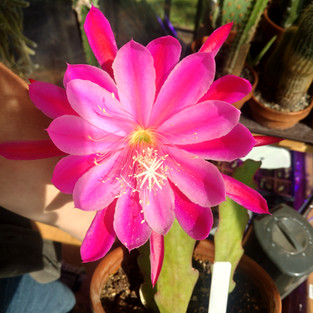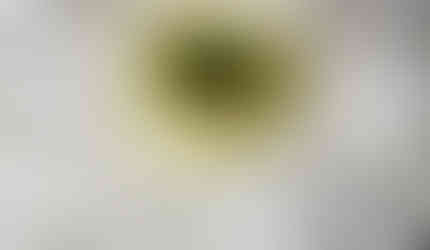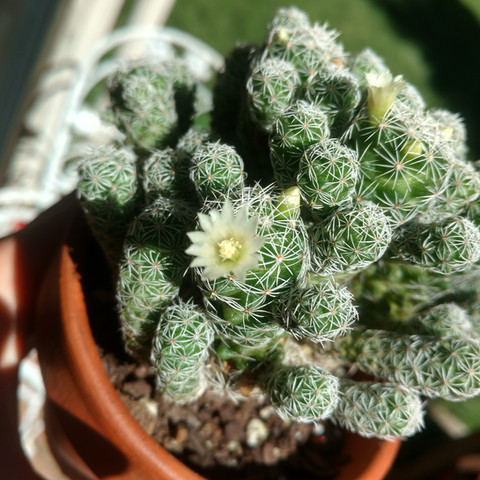All About Cactus Flowers
- Conrad Smith
- Jun 28, 2020
- 4 min read
Updated: Sep 10, 2020
I've often been asked what it is I see in cacti, why I exert so much effort on such "prickly, ugly" plants. Aside from the common answers I give, such as their low maintenance and lack of allergens or toxins, are their flowers. There is a sort of poetic justice in a cactus bloom. They are very harsh plants, but they produce the most spectacular flowers.
Cactus flowers, like the plants that bear them, display an incredible diversity, with every size, shape and scent being represented. That said there are some universal similarities. Cacti have the ability to produce betacyanins (much like their relative the rose), leading to fantastic red and purple colors, however they completely lack the ability to produce any blue pigments (so, yes blue cactus flowers are quite fake). For the purposes of this post, I only discuss flowers that I have had experience with, or have bloomed in our collections.
Christmas Cacti
The Christmas cactus flowers that you are probably familiar with come off of Schlumbergera truncata, however there are, depending on whom you ask, approximately nine species in the genus Schlumbergera (look up Schlumbergera opuntioides if you want to see something really weird). S. truncata’s flowers are described as zygomorphic (basically meaning asymmetrical), their elongated, sort of curved, slanted look, is actually because they are pollinated by hummingbirds in their native environment. The shape is to better allow the birds to sip their nectar (and yes, they do have nectar, if you cut open the flower you will find it at the base of the floral tube), as they flit from flower to flower they transport pollen on top of their heads.
Schlumbergera russellania is another common Christmas cactus species you may come across, S. russellania’s flowers have radial symmetry.
Disocactus ackermannii
Disocactus ackermannii, often erroneously labeled as an Epiphyllum (it’s not) is a particularly interesting plant. It’s stems are similar to that of an Epiphyllum (hence the common confusion), however unlike most Epiphyllums, it’s flowers possess a nectary, are primarily bird pollinated, last for 48 hours, lack elongated sepals and are day blooming. The flowers themselves are spectacular, with a trumpet shape, yellow center, and red, violet whorls radiating outward. In my own experience the colors are so intense into the ultraviolet spectrum that it over saturates the red colors in any digital photographs, making it difficult to adequately photograph.
Scroll through to view a sequence of the flower opening.
Epiphyllum
Epiphyllums are often thought of as the “king” of cactus flowers, due to their impressive size and color. Epiphyllum is a genus of about nineteen species. Most Epiphyllums you will encounter will be highly hybridized, however E. oxypetalum and E. hookeri spp. guatamalense are worthy of mention. As a general rule non-hybridized Epiphyllums are have night blooming, white flowers, with extremely pungent aromas. Typically they are pollinated by moths (hence the sweet scent). Their bright white color helps moths find them by reflecting as much moonlight as possible.
The Epiphyllum Variety in the photographs from our greenhouse is "celeste".
Epiphyllum guatamalense montrose produces rather ephemeral flowers, they only last approximately four to six hours. This plant produces myriad flowers over the course of the late spring, summer and early fall. These particular flowers were "caught" blooming at 11:00 PM EST.
Opuntia
Opuntia are largely bee pollinated. They typically bloom over the course of 48 hours, closing once at night in between. Blooming occurs in late May and early June. Although they can have a wide variety of colors, those endemic to the Eastern United States typically have peach, yellow or orange flowers. Opuntia humifusa and Opuntia macrocentra both have nearly identical flowers. Opuntia cespitosa (easily a favorite) has yellow petals with a deep orange-red center (which acts as a pollen guide to bees). Opuntia macrorhiza possesses a large, mildly scented flower with “frilly” petals. It blooms twice, on the first day it is bright yellow and on the second it is a pale orange color.
Hatoria
Also known as the “drunkard’s dream cactus”, it produces small yellow flowers, resembling that of the whitsun cactus or closely related christmas cactus.
Cereus repandus
Known commonly as Peruvian apple cactus, Cereus repandus is a night blooming plant, producing large bell shaped, cream colored flowers. Flowers typically bloom in the early morning (around 3:00 AM or so). They produce an interesting scent, which can be described as both sweet and musky, on account of the plants' pollinators, bats and moths. Moths are attracted to the sweet scent and bats are attracted to both the sweet and musky scents of the flowers. The blooms of similar cacti will produce sulfur aerosols, similar to those produced in bat musk, to imitate the scent of male and female bats as a ruse to increase the bat’s attraction to the flowers. Fascinatingly C. repandus has been found to actually track the phases of the moon and align its blooming cycle to precisely coincide with the full moon. It is theorized that this behavior evolved to increases the relative visibility of its bright white flowers to potential pollinators.
Cereus repandus flower in bloom over the course of the night and into early morning.
The flower began blooming in late August at around 8:00 PM EST, reached peak bloom at around 1:00 AM and began to close around 7:00 AM.
Cereus repandus flowers, as with that of many night blooming cacti, are exceptionally large.
Honorable Mentions
Here are a few other plants that have bloomed in our collections, that have flowers of interest.
Pediocactus simpsonii
Pediocactus simpsonii, growing in our green roof beds. P. simpsonii is incredibly cold hardy and relatively tolerant of moisture. It is capable of surviving in the eastern United States down to USDA climate zone 5, provided that it has well draining soil. Flowers are bee pollinated, blooming in late March, early April in the Mid-Atlantic United States.
Echinopsis chamaecereus x 'Rose Quartz'
Echinopsis chamaecereus Rose Quartz is a hybrid of the Echinopsis genus. It produces myriads of absolutely stunning 4 cm to 6 cm flowers with red, violet colors deep into the Ultraviolet spectrum, making it difficult to photograph with digital cameras.
Echinopsis chamaecereus 'Westfield Alba'

Echinopsis chamaecereus 'Westfield Alba' is another variety of E. chamaecereus, only with pure white flowers.
Mammillaria gracilis fragilis
M. gracilis fragilis forms small (1 cm) cup-shaped flowers.



















































































































Comments